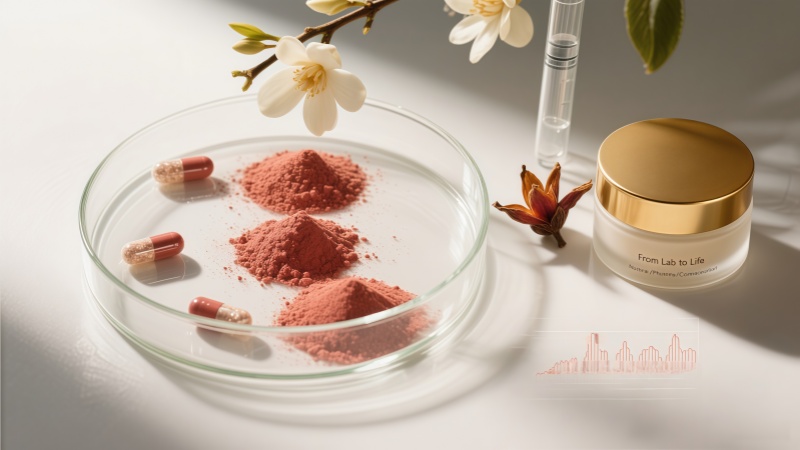Ácido croceico (crocetina) CAS 27876-94-4: Un carotenoide multifuncional para la salud cosmecéutica
El ácido croceico (crocetina), con n.º CAS 27876-94-4 y fórmula molecular C₂₀H₂₄O₄, es un notable carotenoide multifuncional procedente de Crocus sativus L. (estigma de azafrán) y frutos de Gardenia jasminoides. Se presenta en cristales ortorrómbicos de color rojo ladrillo y tiene un peso molecular de 328,40 g/mol.
Nombre del producto :
CrocetinN.º CAS :
27876-94-4Apariencia :
Brick-red orthorhombic crystalsEspecificación :
98%N.º CAS: 27876-94-4
Fórmula molecular: C₂₀H₂₄O₄
Peso molecular: 328,40 g/mol
Aspecto: Cristales ortorrómbicos de color rojo ladrillo.
Fuente: Crocus sativus L. (estigma de azafrán), frutos de Gardenia jasminoides

Carotenoide multifuncional para la salud metabólica y celular
≥99 % de pureza (validado por HPLC): consistencia de lote a lote garantizada.
Regulador del metabolismo biliar: reduce la bilirrubina en un 52% en conejos con conducto biliar ligado (dependiente de la dosis).
Actividad antiaterogénica: disminución del 63% de las placas aórticas en modelos de conejos alimentados con colesterol.
Hepatoprotección y salud metabólica
Apoyo para EHGNA/hígado graso: 100 mg/kg/día reduce los triglicéridos hepáticos en un 48 % a través de la activación de AMPK.
Manejo del colesterol: inhibe la formación de placa arterial en modelos hipercolesterolémicos.
Aplicaciones oncológicas
Actividad antitumoral: actúa en sinergia con agentes de quimioterapia (por ejemplo, doxorrubicina) e induce apoptosis a través de la vía Bax/Bcl-2.
Beneficios cosmecéuticos
Protección UV: Las formulaciones tópicas del 1 al 3 % inhiben la MMP-1 (82 %) y previenen la degradación del colágeno.
| Parámetro | Especificación |
|---|---|
| Pureza | ≥99 % (HPLC-DAD, λmáx. 238 nm) |
| Punto de fusión | 285–286 °C |
| Solubilidad | Soluble en soluciones de piridina/alcalinas; insoluble en agua, etanol, metanol. |
| Almacenamiento | 2–8 °C en recipientes herméticos y resistentes a la luz (estabilidad de 24 meses) |
| Impurezas clave | Disolventes residuales ≤0,5 % (monitorizado mediante GC-MS) |
| Densidad | 1,085 ± 0,06 g/cm³ (20 °C) |
1. Nutracéuticos y productos farmacéuticos
Formulaciones para la salud del hígado: cápsulas de 50 a 100 mg para el manejo de la EHGNA y el colesterol.
Adyuvantes oncológicos: mejoran la eficacia de la quimioterapia y reducen la toxicidad (dosis de 10 a 25 mg/kg).
2. Alimentos funcionales
Colorante natural: Aprobado para bebidas/productos horneados (pH estable en emulsiones alcalinas).
3. Cosmecéuticos
Sueros antienvejecimiento: concentraciones del 1 al 3 % en bases PEG-400 para administración tópica.
1. Tecnología de extracción ecológica
Sin disolventes, rendimiento ≥96%, energéticamente eficiente frente a los métodos con disolventes.
2. Listo para el cumplimiento global
Metales pesados controlados (como <0,1 ppm, Pb <0,2 ppm; ICP-MS).
3. Estabilidad del polimorfo
Los cristales ortorrómbicos mantienen la integridad a ≤140 °C (ideal para la compresión de tabletas).
| Cantidad | Método de embalaje | Duración |
|---|---|---|
| 5 mg–100 mg | Vial de vidrio ámbar + desecante | 24 meses |
| 1 g–5 kg | Tambor de HDPE de grado farmacéutico + sello de vacío | 24 meses |
| 10–25 kilogramos | Tambor de fibra certificado por la ONU (paletizado) | 24 meses |
Toxicidad aguda: LD₅₀ (oral, rata) >5000 mg/kg; no genotóxico.
Sin alérgenos: certificado sin gluten, lácteos ni frutos secos.
P1: ¿Cómo verificar la actividad antitumoral en lotes?
→ Se incluyen informes de ensayos de apoptosis específicos de lotes (células HL-60/SMMC-7721).
Q2: ¿Solubilidad para formulaciones inyectables?
→ Utilizar portadores a base de piridina (solubilidad ↑ a 50 mg/mL).
P3: ¿Estabilidad en alimentos funcionales de alto pH?
→ Estable a pH 8-10 con 0,1% de antioxidante palmitato de ascorbilo.